Mon 26 Dec 2016
JONATHAN LEWIS: Music I’m Listening To — ELVIS PRESLEY “Little Egypt.”
Posted by Steve under Music I'm Listening ToNo Comments
Mon 26 Dec 2016
Sun 25 Dec 2016
W. SOMERSET MAUGHAM – Christmas Holiday. Doubleday Doran & Co, hardcover, October 1939. Reprinted many times.
CHRISTMAS HOLIDAY. Universal Pictures, 1944. Deanna Durbin, Gene Kelly, Richard Whorf, Dean Harens, Gladys George, Gale Sondergaard, David Bruce. Screenwriter: Herman J. Mankiewicz, based on the novel by W. Somerset Maugham. Director: Robert Siodmak.
Raymond Chandler once commented favorably in passing on Somerset Maugham’s 1939 novel Christmas Holiday, which I happened upon at a flea market a week after reading Chandler’s comment. Okay, it has Murder in it, and even a bit of detective work, I guess, but it’s no more a Mystery than Anna Karenina is a Joke Book.
A young man goes to Paris over the Holidays to sow a wild oat or two, gets set up with a prostitute, and is so moved by her devotion and her personal tragedy that he forgets to sow any oats at all. Seems she was a poor working girl who got married to a nice young man who turned out to be a thief and a killer. And she’s working now as a hooker, partly to help him out in prison and partly because of the guilt she feels over his failures.
It’s a damfine novel, and I can see why Chandler enjoyed it; the central theme of a decent fellow doing a little bit of good without making a fuss about it must have appealed to him a lot.
Christmas Holiday was turned into a movie, kinda, by Universal in 1944, one of those films that runs roughshod over the source, then comes out completely different and quite enjoyable by its own lights.
The basic elements of Maugham’s novel are all there — a sardonic reporter introduces a callow young man to the prostitute wife of a convicted killer; the young man does her a small favor and learns something in the process — but the Universal execs, with the wisdom of their breed, hired writer Herman Mankiewicz to add lots of lurid bits to the proceedings, and got director Robert Siodmack to layer on dollops of sinister noir stylistics. The result is rather a far cry from what Maugham actually wrote, but it’s also an engagingly perverse and chilling film, despite the off-key casting of musical stars Gene Kelley and Deanna Durbin.
Sat 24 Dec 2016
THE BURMA CONSPIRACY. French, 2011. Released in France as Largo Winch II. Tomer Sisley, Sharon Stone, Uklrich Turkur, Napskpaha (Mame) Nakapraste, Olivier Bartelemy, Laurent Terzieff, Nicholas Vaude, Clemens Schick, Dimitry Nazarov, Nirut Siridranya. Screenplay by Julien Rappeneau, Jerome Salle, and Jean Van Hamme. Based on the bande dessinees Largo Winch by Jean Van Hamme and Phillipe Francq. Directed by Jerome Salle.
If you tire of endless superheroes, spies, and cop buddy movies in your blockbuster action movie fare, The Burma Conspiracy, aka Largo Winch II, may be just what you are looking for.
A sequel to Largo Winch, which introduced the character of the Bosnian-born son of Yugoslav billionaire Nerio Winch, who inherits his father’s vast wealth and the W Group with over four hundred thousand employees worldwide, this French action film picks up where the first film left off.
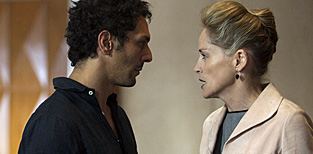
Based on the international hit Belgian bande dessinees by writer Jean Van Hamme and artist Phillipe Francq we pick up as Largo (Tomer Sisley) is planning to sell the W Group and use all his wealth in a planned charitable foundation named for his father, and no sooner has he signed the papers to enable the sale than his yacht is invaded by UN investigators accusing him of involvement in the slaughter of a Karen tribe Burmese village, Kaipu, by war criminal General Kyaw Min (Nirut Siridranya) so that his father could buy their nickel rich land.
Now Largo, with a small band of loyal friends, his lawyer Dwight Cochrane (Ulrich Tukur), his valet Gauthier (Nicholas Vaude), Alexandre Jung (Laurent Terzieff) an old friend of his father, and Simon (Olivier Barthelemy) a ne’er-do-well friend he once saved in the Burmese jungle, has to get to the bottom of the conspiracy against him while evading prosecution by Francken, a vengeful billionaire businessman Nazatchov (Dimitry Nazarov) who is trying to buy the W Group, and a murderous mercenary Lazarevic who wants to kill him. And in a game like this, can anyone be trusted?
As Largo’s favorite Bosnian proverb goes: “A man with no enemies is no man at all.â€
Packed with action, intelligent characters who nevertheless don’t always act in their own best interest, and a surprising amount of heart for an action movie, the film is both picaresque and sharp. The hero is no superman, and needs rescuing as often as comes to the rescue. Tomer Sisley manages to be both strong and vulnerable as Largo, believable in the most outrageous action scenes.
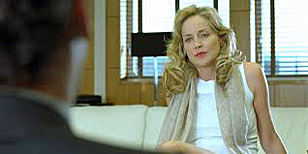
The film is filled with spectacular action and stunts and extremely handsome locales from Geneva to Hong Kong, with action in the jungles of Burma and the streets of Bangkok, and set pieces including a jungle prison camp escape and a breathtaking skydiving battle and rescue. But unlike so many action films, this one takes time to develop characters, to allow for actual human beings to emerge, for humor and a touching romance, and actual suspense that for once waits until almost the last moment to reveal the villain behind Largo’s problems, whose motive is actually quite strong.
It’s nice for once to see a movie where the hero and not the entire civilized world is at stake, particularly one as stylish and smart as this. If this is the sequel, I’m even more anxious to see the first one. If you are looking for a fast moving action film with a big budget that neither insults your intelligence nor sprains your suspension of disbelief beyond repair, this may be the film for you.
Sat 24 Dec 2016
Bubble Puppy was a psychedelic rock band from Texas in the late 60s and early 70s. Their biggest hit was “Hot Smoke & Sasafrass,” the first track on this, their only album under this incarnation (and name) of the group, from 1969:
Fri 23 Dec 2016
TERROR STREET. Lippert Films, US; Hammer Films, UK, as 36 Hours, 1953. Dan Duryea, Elsy Albiin, Ann Gudrun (Gudrun Ure), Eric Pohlmann, John Chandos, Kenneth Griffith. Story and screenplay: Steve Fisher. Director: Montgomery Tully.
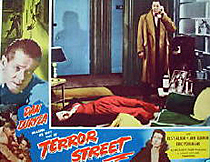
This is one of several movies recently marketed on DVD in this country as “Hammer Noir” films. What they were in reality were joint British-American productions in which a single star was imported from the US (Dan Duryea, of course, in this case) to make a movie — quite often a crime film — on a low budget in England, with the rest of the cast consisting only of British and European actors and actresses.
On the basis of Terror Street, I’d say that the emphasis is on the cheap, with inexpensive sets prevailing; on the other hand, there is plenty of exterior shooting that provides a glimpse of the non-touristy areas of London in the early 1950s.
But before going any further, let me tell you about the story. Dan Duryea plays an American flier named Rogers who marries a Norwegian girl (Elsy Albiin) he meets in England after the war, and they settle down there. When he’s called back to the States for some sort of training program, they have their first quarrel. Three months having turned into a year without hearing from her, he goes AWOL and heads back to England to see her and to learn why she’s cut off all contact with him.
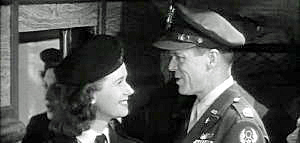
And guess what. She opens the door to her apartment where he’s sitting quietly waiting for her, he’s clunked on the head from behind, and he wakes up to find her shot to death beside him, his gun (and the murder weapon) in his hand.
Not waiting for the police to arrive for them to not believe his story, he heads out on the lam — and straight into the arms of Jenny Miller (Ann Gudrun) who works in a charity kitchen, which may help to explain why she takes him on as a charity case of her own.
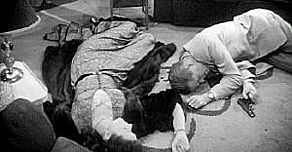
This is not a detective story — we the viewers have already seen the killer do the deed, although of course we do not know who he is or why he did it. Nor, believe it or not, is this much of a suspense yarn, even though that’s the gimmick that’s meant to keep the story moving: Rogers has only 36 hours before his superiors learn that he’s gone, having smuggled himself into England without either their knowledge or permission.
In those 36 hours, his quest is not only to find the killer and clear himself, but to discover why the long-distance romance with his wife broke up so badly. Not realizing in the meantime that Jenny is becoming more and more important to him, and vice versa, only I think she realizes it first. Various sleazy types try to stop them.
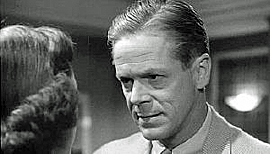
A true noirish situation, right? It was concocted by a writer who started his career writing for the pulp magazines, but this time, nothing that happens seems to ring true, and Duryea appears almost too tired and out of sync to pull off the role he’s to play here, that of both hero and victim. (In his early days of film-making, as you probably need not be reminded, Duryea was usually a villain.)
Other than Duryea, the actors are rather stolid folk, with only Ann Gudrun, who was born in Scotland, showing much spark. She was only 5 foot 3, I’m told, but she plays her role with a restrained combination of wistfulness and strength.
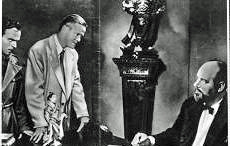
Elsy Albriin is pretty without being beautiful, and if she’d been given a longer role, maybe some of the stiffness she shows early on would have worn away. She did not have a very long career in either TV or the movies, especially in English-speaking roles.
One last generalization, then, and I think it applies here as well. Whenever I watch a movie and all I see are actors standing on a soundstage, that’s when I know when neither the story nor the players has any kind of hold on me. No mesmerizing movie-time spells were cast this time. While in no sense did I find Terror Street disastrously bad, watching it was largely a disappointment for me.
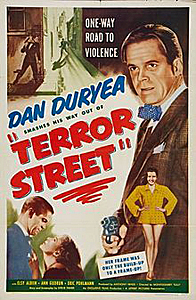
Fri 23 Dec 2016
PATRICIA HIGHSMITH – Ripley Under Water. Tom Ripley #5, Alfred A. Knopf, hardcover, 1992. Vintage, trade paperback, 1993.
Highsmith’s novels of Tom Ripley, the amiable sociopath, have gotten a good deal of critical acclaim. In the fifth and latest, Ripley and his wife Heloise are living happily in France with not a care in the world, until a couple of odd and unattractive Americans rent a house nearby. Soon it becomes apparent that they know, or at least suspect, a great deal more about Ripley’s past transgressions (which include art fraud and a few ad hoc murders) than they have any right to; and that they want him to know it.
The questions are how much do they know and what do they intend to do with it? Ripley’s reactions will come as no surprise to readers of previous books in the series. I found this a distinctly lesser effort. I had liked earlier books well enough, but here the credibility of Ripley’s foes was lacking, their motivations murky, and just how they knew all they seemed to know was not well established.
Highsmith is a good writer without question, but I didn’t think this was a good book.
Fri 23 Dec 2016
Odessey and Oracle (1968) is the second studio album released by the British rock band The Zombies. At one time it was ranked number 100 on Rolling Stone‘s list of the 500 Greatest Albums of All Time:
Thu 22 Dec 2016
EARL EMERSON РCatfish Caf̩. Ballantine, hardcover, August 1998; paperback reprint, September 1999.
This is number eleven in a series of what is so far fourteen books chronicling the cases of Seattle-based PI Thomas Black. The most recent is Two Miles of Darkness from 2015. It’s a good series. I read the first three when they first came out, but I regret to say I’ve been rather hit-and-miss with them from that point on.
In Catfish Café Emerson does something I think is rather daring. The case that he takes on is that of finding the daughter of his former partner on the police force; she’s gone missing after leaving the scene of an automobile accident, leaving the body of a dead man behind.
What is something out of the ordinary about this is that Luther Little, the girl’s father, is black, and in order to solve the case, Black has to maneuver his way through all kinds of secrets accumulated over the years by Luther’s very extended family. Not the kind of job a PI likes to do in general, but Black is white, and it takes a special knack on his part to make any kind of headway into prying the secrets loose.
There are wives and former lovers, daughters, sons and stepsons, fathers, uncles and cousins, a spunky grandmother, boy friends and more. The family is not poor, but neither are they well off. Many of them have problems. Some have prison records; the daughter Black is looking for has had a life on the streets.
To his credit, Emerson describes this family in detail well enough to convince me. The book is a long one, so it does seem to sag a little in the middle, but it’s also a complicated and interesting one. The ending also manages to gather up all the loose ends in satisfactory fashion, if not entirely happily to all of the various members of Luther’s family.
Thu 22 Dec 2016
I ESCAPED FROM THE GESTAPO. Monogram Pictures, 1943. Dean Jagger, John Carradine, Mary Brian, Bill Henry, Sidney Blackmer, Ian Keith. Director: Harold Young.
Talk about great casting. I Escaped from the Gestapo stars Dean Jagger as Torgut Lane, an escaped convict forced to work against his will as a counterfeiter for a Nazi spy ring and John Carradine as “Martin,†a Nazi saboteur and the head of the aforementioned spy ring. Both men portray their characters to the hilt in this offbeat, occasionally thematically quite dark, World War II era thriller, one that cinematically looks something like a cross between an action-packed film serial and an early film noir.
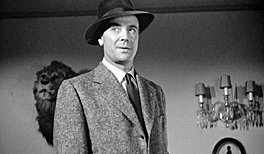
With a running time of seventy-five minutes, this programmer provides a surprising degree of characterization for noted forger Torgut Lane, demonstrating that during wartime even criminals can remain fierce American patriots. After Lane receives assistance in breaking out of prison, he soon comes to learn that his newfound friends aren’t friends at all. Rather, they are Nazi saboteurs based in Los Angeles who have decided they’ll hold Lane in virtual slavery while he works to produce counterfeit bank notes for them. Lane may be a criminal. But he’s no Nazi! And from the very beginning of his newfound captivity, he begins looking for ways to undermine the sinister Nazi plan against democracy.
I’d be remiss if I didn’t mention how perfectly suited John Carradine is to the role of the mysterious “Martin,†the Nazi ringleader. Urbane and polished on the surface, Martin’s deep down a true cold-hearted brute. In one particularly galling scene – one which likely shocked respectable audiences at the time – Martin sits and reads a book while his henchman beats Torgut Lane with a rubber hose. It’s a scene that would have fit well in the context of a late 1940s film noir, but seems unusually violent for a film released in 1943.
It’s also worth mentioning that the film also contains a rather unique subplot involving a Gestapo agent tasked with guarding Lane. The man named Gordon (Bill Henry) never smiles and has a killer’s look in his eyes. This leads Lane, who is clearly adept at reading people, to nickname Gordon “The Butcher.†As it turns out, Lane’s instincts are spot on. The man guarding him has a brutal past and is guilt-ridden from the atrocities in which he has participated against European Jewry while he was still in Europe. Lane is able to exploit this guilt to his own benefit. It’s a plot element that further solidifies my opinion that I Escaped from the Gestapo is far from a forgettable morale booster during wartime and is well worth a look.